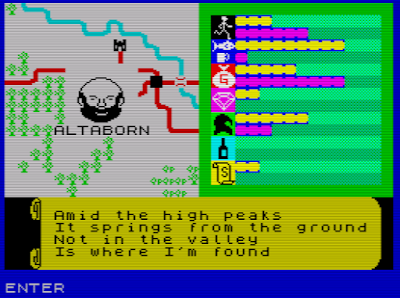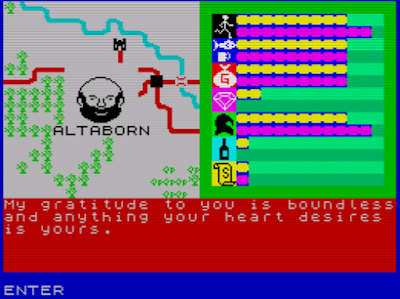 |
| You would think these portraits are the Masters of Serebal, but instead they're the bridge guardians that you have to fight throughout the game. |
The Masters of Serebal
United Kingdom
M. C. Lothlorien (developer and publisher)
Released 1984 for ZX Spectrum
Date Started: 3 July 2020
Date Ended: 9 July 2020
Total Hours: 6
Difficulty: Hard (4/5)
Final Rating: (to come later)
Ranking at time of posting: (to come later)
I was looking for an "afternoon RPG"--an entry I could bank in case I ran out of time in September. I figured a ZX Spectrum game from 1984 couldn't possibly be that long. As usual, I underestimated the ability of 1980s developers to really drag out a game, this time by repeating essentially the same quest 10 times. Still, The Masters of Serebal showed me a few new things, and the experience overall was worthwhile.
Serebal is a cassette game from Cheshire-based M. C. Lothlorien, which sounds like the worst hip-hop name of all time. (Its author, Keith Hunt, is credited on a spy adventure from the same year called Special Operations and nothing else.) The word Serebal is never really explained in the game or its backstory, but it seems to mean something akin to "magic." The story goes that 5,000 years ago, the eleven races of the world were united by the Masters of Serebal under the Eleven Scrolls of Law. Each scroll was trusted to a different race, and together their power kept darkness at bay. But now millennia have passed and the power of the scrolls is waning. Only humans have kept the faith; the other races have mutated and crossbred into around 400 different species today. Now it's time for a hero to unite the Eleven Scrolls, with the help of a modern Serebal master named Altaborn.
There's no character creation process. The player is already assumed to be a famous warrior who has agreed to take on this quest. He begins in his village, in the southwest corner of a map of 48 x 48 squares. Half of the screen is dedicated to the game map; the other half shows the character's current resources as colored dots in two rows. From top to bottom, those resources are stamina, food, gold, gems, armor, healing potions, and the scrolls. Each yellow dot represents one while each blue dot represents 10, so the starting character has 67 stamina, 24 food, and 45 gold.
The keyboard and joystick have redundant controls for movement, but the keyboard is used for most game actions, including options like B)uy (only works on towns), D)rink a potion, and R)est to trade food for health. Controls are easy to master but execute so slow at era-accurate speeds that the only way to make the game tolerable is to crank up the emulator.
The game map has roads, towns (where you can buy more food and armor), and various terrain features in which you find the scrolls. Altaborn holds the first scroll, so once you start the game and visit his castle, you only need to find 10 more. The game's gimmick is that each scroll has a clue for how to find the next one. The clues refer to the terrain features on the map, and figuring them out is perhaps the most fun part of the game. The first, as an example, is:
Between the waters
So wide and so bare
With death all around
You'll find me there
The riddle refers to the northern central part of the map, where an expanse of desert lies between two rivers. There's a single patch of grass in the desert, and that's where I found the dungeon containing the first scroll. Altaborn gives you a ring that tells you when you've stepped on the right square. You have to do them in a precise order, so you can't just lawnmow the game and get all 11.
You wouldn't want to do that anyway because of the food and combat systems, which together ruin most of the enjoyment the game otherwise offers. The game is particularly proud of its bestiary, which includes some 400 monsters (the "races" of the backstory). You can scroll through and admire their icons at any time by hitting the G)uide option. The developer basically put 20 different heads onto 20 different bodies. The effort is a bit wasted since none of the monsters are named and none do anything different than the others.
Encounters happen randomly every 15 steps on average, but with a large variance. Combats are a miniature arcade game. Both foes are assumed to be using special three-pronged ranged weapons called "triorangs," which are functionally just dots that zip across the screen when you hit FIRE on the joystick. You and the enemy maneuver around an area full of obstacles (including deadly plants that can damage you if you bump them) and try to shoot at each other. The weapons don't work if you're immediately adjacent to the enemy, which is too bad because every foe is like a clinching boxer who makes a beeline for you and does his best not to leave your side. You end up running around and using obstacles to trap enemies with the game's limited pathfinding, then popping around corners to shoot them. This is hard because the moment you have a clear shot against the enemy, he also has a clear shot against you. It's very hard to put yourself in a situation in which you can fire with impunity, although sometimes the obstacles arrange themselves in just a way that you can shoot through them but not travel; the enemy never exploits such an arrangement while you can.
 |
| The combat screen. I was able to trap this enemy where I could shoot at him but he couldn't squeeze himself. |
Ultimately, though, the fighter with the highest number of hit points (a combination of stamina and armor) is heavily favored to win the battle. The good news is that because of the Eleven Laws, enemies don't actually kill each other in this setting; they just knock each other unconscious and take some of their food and gold. You can lose a fair number of combats and still keep questing. The economy is tight enough that you want to be sure to win at least two out of three, however.
As if random combats weren't enough, every bridge crossing in the game requires you to fight the "guardian of the bridge" or pay a gem (worth 1000 gold pieces) as a toll. For some reason, these jackasses get their portraits on the title screen.
 |
| My life would be more interesting if the Tobin Bridge adopted this rule. |
The food system is also a source of constant annoyance. You eat some every step, and once it's gone, you start losing stamina instead until you die. You're capped as to how much food you can carry by your current stamina, and even at the maximum, it's not enough to do much random exploring before you have to hustle back to town and buy more. If you run out of money, you're really screwed. Altaborn gives you a nice cash boost every time you return with a scroll, but in between those times, you're limited to making money from combats and random encounters, neither of which supplies enough to offset the food you eat while trying to find those encounters. The system thus heavily encourages you to save the game, explore until you find the next scroll--deliberately taking a dive on each combat just to hustle things along--then reload and go directly to the scroll location, thus saving all the food, stamina, and gold you would have otherwise wasted wandering around. Weirdly, even as your maximum stamina and thus maximum food increase as the game goes along, you still seem to consume at the same rate throughout the game. That is, you can only walk about 30 steps (depending a bit on terrain) before you run out of food, no matter whether you start with 24 units or 104.
 |
| Running out of resources. |
The game has a variety of fun random encounters to offer some variety during exploration. You might meet some friendly peasants who give you some food, or you might lose health running from a leper colony. You can find gold and gems in unexpected caches. Occasionally, a wandering trader will sell you food, which is almost always welcome. And if you wander too long looking for the next scroll, a helpful adventurer will show up and give you a hint.
Once you have a sense of the terrain, however, the scrolls' clues are relatively easy to interpret. When you reach their locations, the game has another surprise. To find them, you have to descend into a dungeon, which you explore in a first-person view. Confusingly, the directional commands do not change with the new perspective, so even if you're facing east, you still move the joystick to the right to move east; in other words, pushing the joystick upwards always moves you north rather than the direction that you're facing.
The color of the ring is supposed to help you figure out the location of the scroll. Supposedly, it gets yellow when you're "warm" and white when you're "hot." In practice, I didn't find it very useful because the corridor layout made strict geographic proximity to the scroll a bit meaningless.
The dungeons are all 16 x 16 and have the same random encounters as the outside. Each one has a secret door, which you find by moving into it, and behind the secret door is always one fixed encounter with the enemy holding the scroll. These are the only enemies that you must defeat, as a loss will just loop you into combat again. Once you have the scroll, a single key gets you out of the dungeon and back on the map. You return to Altaborn, who rewards you with gold and healing before interpreting the next clue.
Once you bring the final scroll to Altaborn, he has a bit of a speech:
Tolidor be praised--the scrolls are once again reunited! [Tolidor is an ancient Master of Serebal, Altaborn's ancestor.] At last the Law can be restored to the Land. Your accomplishment will be forever remembered by all the peoples of the Earth and your deeds will rank alongside those of the greatest of the Serebal Masters. My gratitude to you is boundless and anything your heart desires is yours.
It took me six hours to win, but that's with a cranked emulator, save states, and a lot of "exploration scumming" as outlined above. I suspect that back in the day, this could have kept a player going for a couple of dozen. I don't think I would have been able to put up with the combats that long. They're what justifies the "hard" difficulty rating. They weren't so hard for me, because I could just reload with a single keypress, but if I had used the game's in-game cassette save, reloading would have been annoying enough that I would have had to shrug off a lot more losses, thus extending the game as I compensated for the associated loss of stamina and food.
Serebal isn't really even an RPG by my definitions, lacking attribute-based combat and any type of inventory beyond potions. There isn't even much development. Every scroll adds a bit to your maximum health, but enemies get harder at the same time. It thus earns a low 13 on my GIMLET, with 1s and 2s throughout. I couldn't find any contemporary reviews or any sign that anyone else had played the game except for a brief YouTube video.
We thus must continue to wait for the truly legendary ZX Spectrum RPG. I'll keep at it.









Commentaires
Enregistrer un commentaire